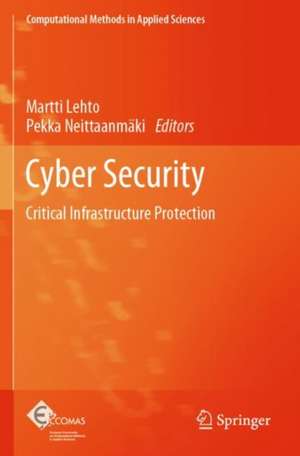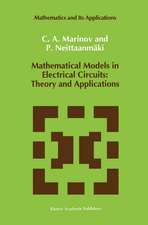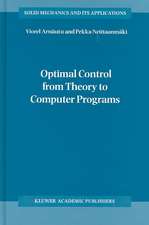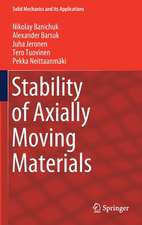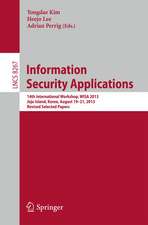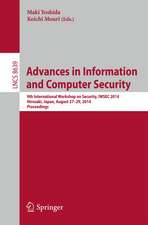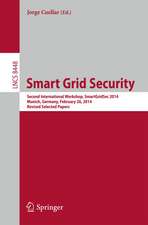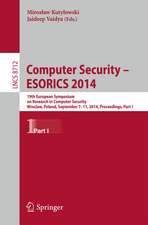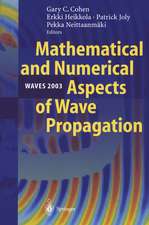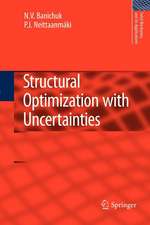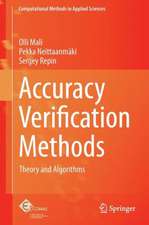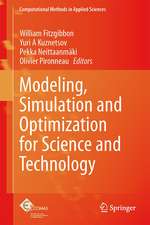Cyber Security: Critical Infrastructure Protection: Computational Methods in Applied Sciences, cartea 56
Editat de Martti Lehto, Pekka Neittaanmäkien Limba Engleză Paperback – 4 apr 2023
This book focus on critical infrastructure protection. The chapters present detailed analysis of the issues and challenges in cyberspace and provide novel solutions in various aspects. The first part of the book focus on digital society, addressing critical infrastructure and different forms of the digitalization, strategic focus on cyber security, legal aspects on cyber security, citizen in digital society, and cyber security training.
The second part focus on the critical infrastructure protection in different areas of the critical infrastructure. The chapters cover the cybersecurity situation awareness, aviation and air traffic control, cyber security in smart societies and cities, cyber security in smart buildings, maritime cyber security, cyber security in energy systems, and cyber security in healthcare.
The third part presents the impact of new technologies upon cyber capability building as well as new challenges brought about by new technologies. These new technologies are among others are quantum technology, firmware and wireless technologies, malware analysis, virtualization.
The second part focus on the critical infrastructure protection in different areas of the critical infrastructure. The chapters cover the cybersecurity situation awareness, aviation and air traffic control, cyber security in smart societies and cities, cyber security in smart buildings, maritime cyber security, cyber security in energy systems, and cyber security in healthcare.
The third part presents the impact of new technologies upon cyber capability building as well as new challenges brought about by new technologies. These new technologies are among others are quantum technology, firmware and wireless technologies, malware analysis, virtualization.
| Toate formatele și edițiile | Preț | Express |
|---|---|---|
| Paperback (2) | 587.76 lei 38-44 zile | |
| Springer International Publishing – 3 ian 2019 | 587.76 lei 38-44 zile | |
| Springer International Publishing – 4 apr 2023 | 1053.98 lei 6-8 săpt. | |
| Hardback (3) | 796.04 lei 38-44 zile | |
| Springer International Publishing – 23 mai 2018 | 796.04 lei 38-44 zile | |
| Springer International Publishing – 10 iun 2015 | 992.44 lei 6-8 săpt. | |
| Springer International Publishing – 3 apr 2022 | 1060.56 lei 6-8 săpt. |
Din seria Computational Methods in Applied Sciences
- 15%
 Preț: 655.27 lei
Preț: 655.27 lei - 15%
 Preț: 651.51 lei
Preț: 651.51 lei - 15%
 Preț: 657.73 lei
Preț: 657.73 lei - 5%
 Preț: 709.87 lei
Preț: 709.87 lei - 18%
 Preț: 1116.26 lei
Preț: 1116.26 lei - 18%
 Preț: 947.35 lei
Preț: 947.35 lei - 18%
 Preț: 1224.54 lei
Preț: 1224.54 lei - 18%
 Preț: 952.89 lei
Preț: 952.89 lei - 18%
 Preț: 947.35 lei
Preț: 947.35 lei - 20%
 Preț: 653.38 lei
Preț: 653.38 lei - 18%
 Preț: 954.45 lei
Preț: 954.45 lei - 15%
 Preț: 638.76 lei
Preț: 638.76 lei - 18%
 Preț: 1005.74 lei
Preț: 1005.74 lei - 20%
 Preț: 648.59 lei
Preț: 648.59 lei - 18%
 Preț: 954.45 lei
Preț: 954.45 lei - 20%
 Preț: 640.19 lei
Preț: 640.19 lei - 18%
 Preț: 1231.16 lei
Preț: 1231.16 lei - 24%
 Preț: 789.37 lei
Preț: 789.37 lei - 18%
 Preț: 946.41 lei
Preț: 946.41 lei - 20%
 Preț: 567.63 lei
Preț: 567.63 lei - 15%
 Preț: 639.25 lei
Preț: 639.25 lei - 18%
 Preț: 952.57 lei
Preț: 952.57 lei - 15%
 Preț: 636.80 lei
Preț: 636.80 lei - 15%
 Preț: 650.69 lei
Preț: 650.69 lei - 18%
 Preț: 952.26 lei
Preț: 952.26 lei - 18%
 Preț: 1239.99 lei
Preț: 1239.99 lei - 5%
 Preț: 716.65 lei
Preț: 716.65 lei
Preț: 1053.98 lei
Preț vechi: 1317.48 lei
-20% Nou
Puncte Express: 1581
Preț estimativ în valută:
201.70€ • 219.02$ • 169.43£
201.70€ • 219.02$ • 169.43£
Carte tipărită la comandă
Livrare economică 22 aprilie-06 mai
Preluare comenzi: 021 569.72.76
Specificații
ISBN-13: 9783030912956
ISBN-10: 3030912957
Pagini: 484
Ilustrații: XVI, 484 p. 73 illus., 63 illus. in color.
Dimensiuni: 155 x 235 mm
Greutate: 0.69 kg
Ediția:1st ed. 2022
Editura: Springer International Publishing
Colecția Springer
Seria Computational Methods in Applied Sciences
Locul publicării:Cham, Switzerland
ISBN-10: 3030912957
Pagini: 484
Ilustrații: XVI, 484 p. 73 illus., 63 illus. in color.
Dimensiuni: 155 x 235 mm
Greutate: 0.69 kg
Ediția:1st ed. 2022
Editura: Springer International Publishing
Colecția Springer
Seria Computational Methods in Applied Sciences
Locul publicării:Cham, Switzerland
Cuprins
Part I: Digital society. Chapter 1: Cyber-attacks Against Critical Infrastructure.- Chapter 2: Key Elements of On-line Cyber Security Exercise and Survey of Learning During the On-line Cyber Security Exercise.- Chapter 3: Cyber Law and Regulation.- Chapter 4: Understanding and Gaining Human Resilience Against Negative Effects of Digitalization.- Chapter 5: Users’ Psychopathologies: Impact on Cybercrime Vulnerabilities and Cybersecurity Behavior.- Chapter 6: Process Ontology Approach to Military Influence Operations.- Part II: Critical infrastructure protection. Chapter 7: Future Smart Societies’ Infrastructures and Services in the Cyber Environments.- Chapter 8: Cyber Security in Healthcare Systems.- Chapter 9: Cyber Security of an Electric Power System in Critical Infrastructure.- Chapter 10: Maritime Cybersecurity: Meeting Threats to Globalization’s Great Conveyor.
Notă biografică
Dr. Martti Lehto, (Military Sciences), Col (GS) (ret.) works as a Professor (Cyber security) in the University of Jyväskylä in the Faculty of Information Technology. He has over 30 years’ experience as developer and leader of C4ISR Systems in Finnish Defence Forces. He served for 30 years in the Finnish Air Force where his last position was Deputy Chief of Staff for Logistics and Armaments in Air Force Command. Now he is Cyber security and Cyber defence researcher and teacher in the IT Faculty. He teaches in MSc and PhD level in the University of Jyväskylä, National Defence University, and Air Force Academy. He is also Adjunct professor in National Defence University in Air and Cyber Warfare. He has participated Finland’s parliament hearings annually from 2013. His research areas are Cyber Security strategy, Cyber Warfare, Cyber Security in Aviation, Cyber security in the Healthcare system, and Critical Infrastructure Protection. Since 2001 he has been the Editor-in-Chief ofthe Military Magazine.
Dr. Pekka Neittaanmäki works as Professor, UNESCO Chair in the University of Jyväskylä. He was the Professor in Information Technology, Numerical Analysis, and Its Applications, in the University of Jyväskylä, 1988–2019. He worked the Dean of the Faculty of Information Technology in the University of Jyväskylä, 2010–2017, the Head of COMAS (Computing and Mathematical Sciences) Graduate School in the University of Jyväskylä, 1995–1999, 2003–2016, the Chairman of Agora Human Centered Information Technology Research Center of the University of Jyväskylä, 2002–2009 and the Vice Rector in the University of Jyväskylä, 1993–2000. He is also the Visiting Professor in the Tokyo Institute of Technology, Japan from 2008 and Adjunct Professor in the University of Houston, USA from 2000. His research Interests are among others reliable computing, optimization, optimal control and logistics, computational methodology in nanotechnology, computational mechanics, dynamical systems and attractors, signal and data processing, big data analytics, critical infrastructure protection, innovative learning, digital service platforms and data analysis, optimization, and simulation in public healthcare.
Dr. Pekka Neittaanmäki works as Professor, UNESCO Chair in the University of Jyväskylä. He was the Professor in Information Technology, Numerical Analysis, and Its Applications, in the University of Jyväskylä, 1988–2019. He worked the Dean of the Faculty of Information Technology in the University of Jyväskylä, 2010–2017, the Head of COMAS (Computing and Mathematical Sciences) Graduate School in the University of Jyväskylä, 1995–1999, 2003–2016, the Chairman of Agora Human Centered Information Technology Research Center of the University of Jyväskylä, 2002–2009 and the Vice Rector in the University of Jyväskylä, 1993–2000. He is also the Visiting Professor in the Tokyo Institute of Technology, Japan from 2008 and Adjunct Professor in the University of Houston, USA from 2000. His research Interests are among others reliable computing, optimization, optimal control and logistics, computational methodology in nanotechnology, computational mechanics, dynamical systems and attractors, signal and data processing, big data analytics, critical infrastructure protection, innovative learning, digital service platforms and data analysis, optimization, and simulation in public healthcare.
Textul de pe ultima copertă
This book focus on critical infrastructure protection. The chapters present detailed analysis of the issues and challenges in cyberspace and provide novel solutions in various aspects. The first part of the book focus on digital society, addressing critical infrastructure and different forms of the digitalization, strategic focus on cyber security, legal aspects on cyber security, citizen in digital society, and cyber security training.
The second part focus on the critical infrastructure protection in different areas of the critical infrastructure. The chapters cover the cybersecurity situation awareness, aviation and air traffic control, cyber security in smart societies and cities, cyber security in smart buildings, maritime cyber security, cyber security in energy systems, and cyber security in healthcare.
The third part presents the impact of new technologies upon cyber capability building as well as new challenges brought about by new technologies. These new technologies are among others are quantum technology, firmware and wireless technologies, malware analysis, virtualization.
The second part focus on the critical infrastructure protection in different areas of the critical infrastructure. The chapters cover the cybersecurity situation awareness, aviation and air traffic control, cyber security in smart societies and cities, cyber security in smart buildings, maritime cyber security, cyber security in energy systems, and cyber security in healthcare.
The third part presents the impact of new technologies upon cyber capability building as well as new challenges brought about by new technologies. These new technologies are among others are quantum technology, firmware and wireless technologies, malware analysis, virtualization.
Caracteristici
Addresses critical infrastructure and different forms of digitalization Covers cybersecurity in aviation and air traffic control Investigates the impact of new technologies upon cyber capability building
Recenzii
“This wonderfully documented text explores themechanics and methods of digital security and the steps necessary to ensureprivacy. … For the professional who is mathematically literate, the book is a must-read.The reference sections that follow each chapter rival that of any PhD thesisever written. It is magnificent in its scholarship.” (James Van Speybroeck, ComputingReviews, October, 2015)
